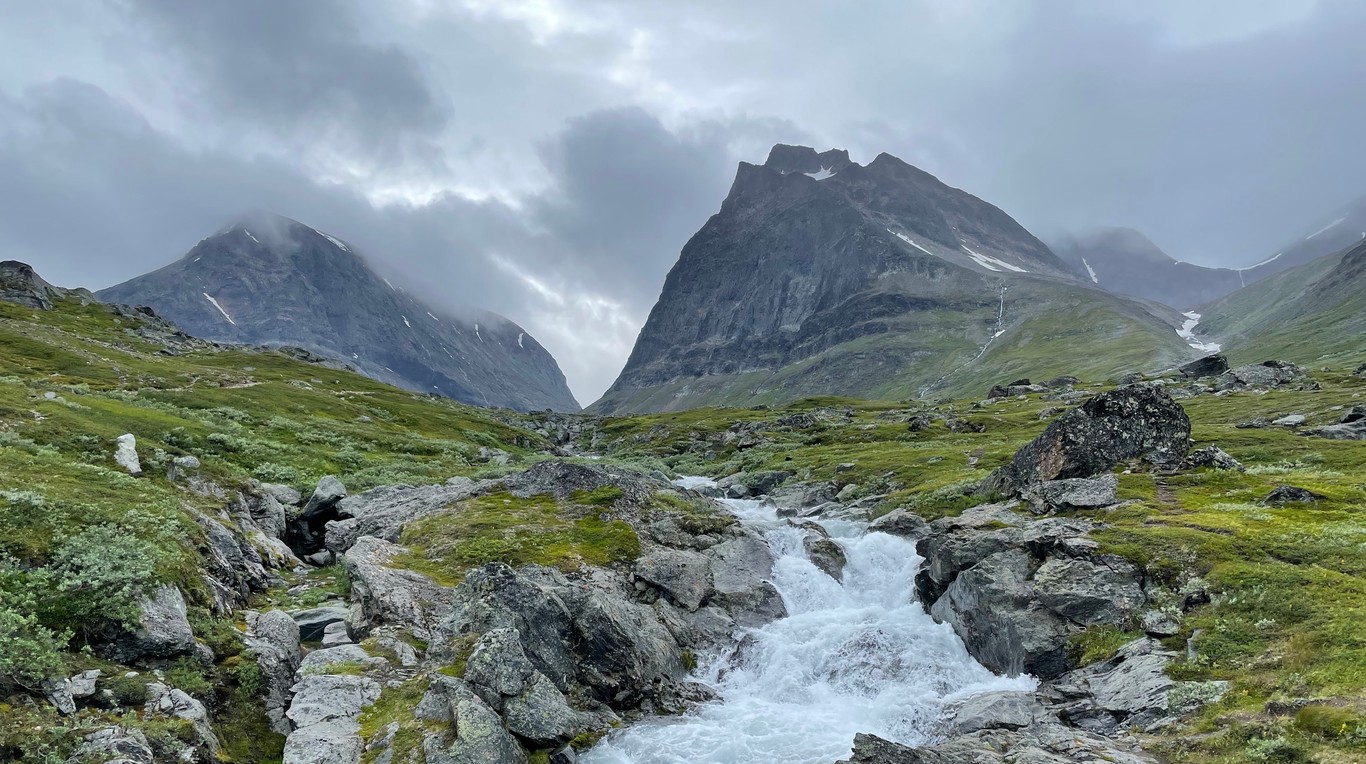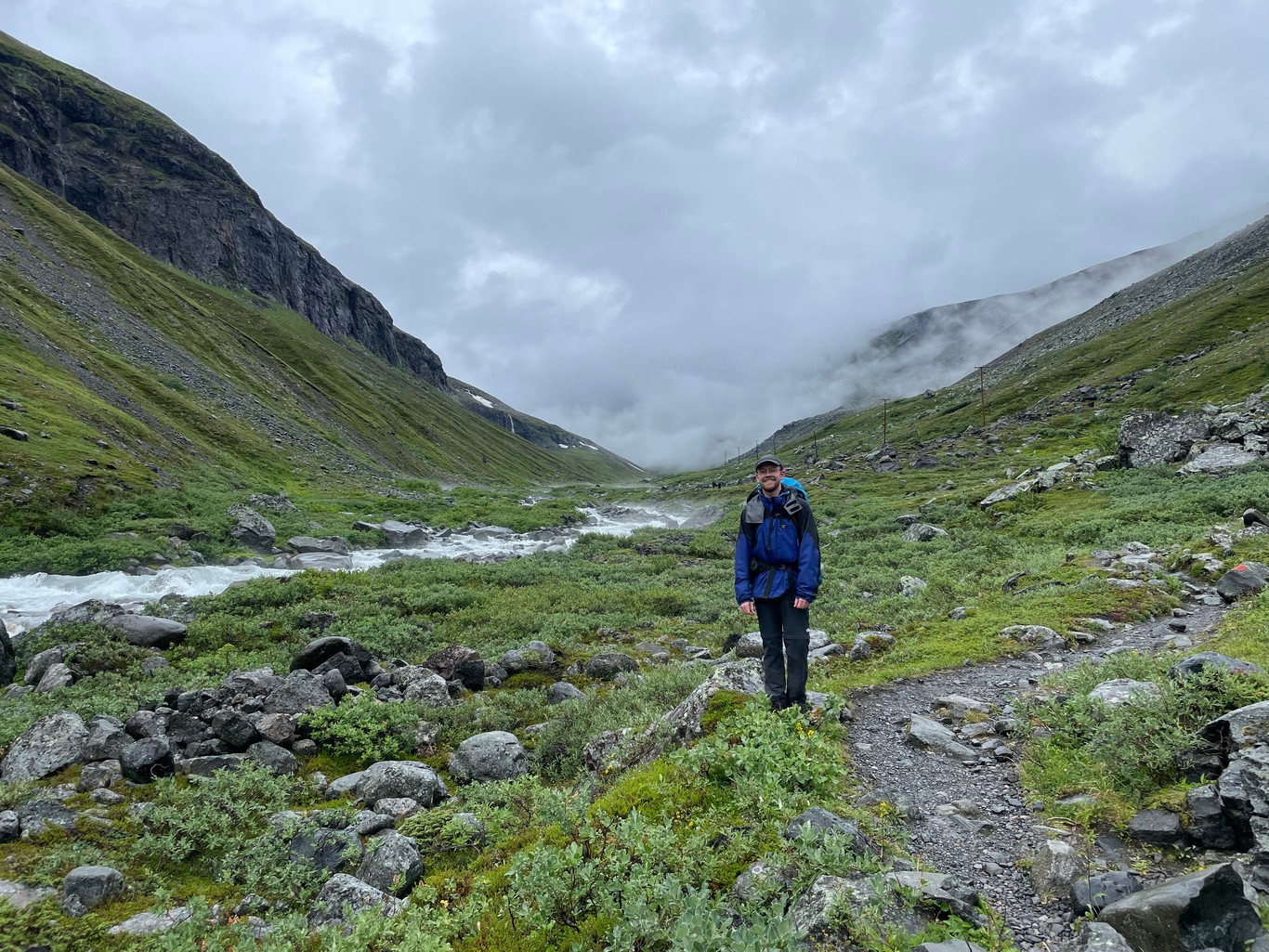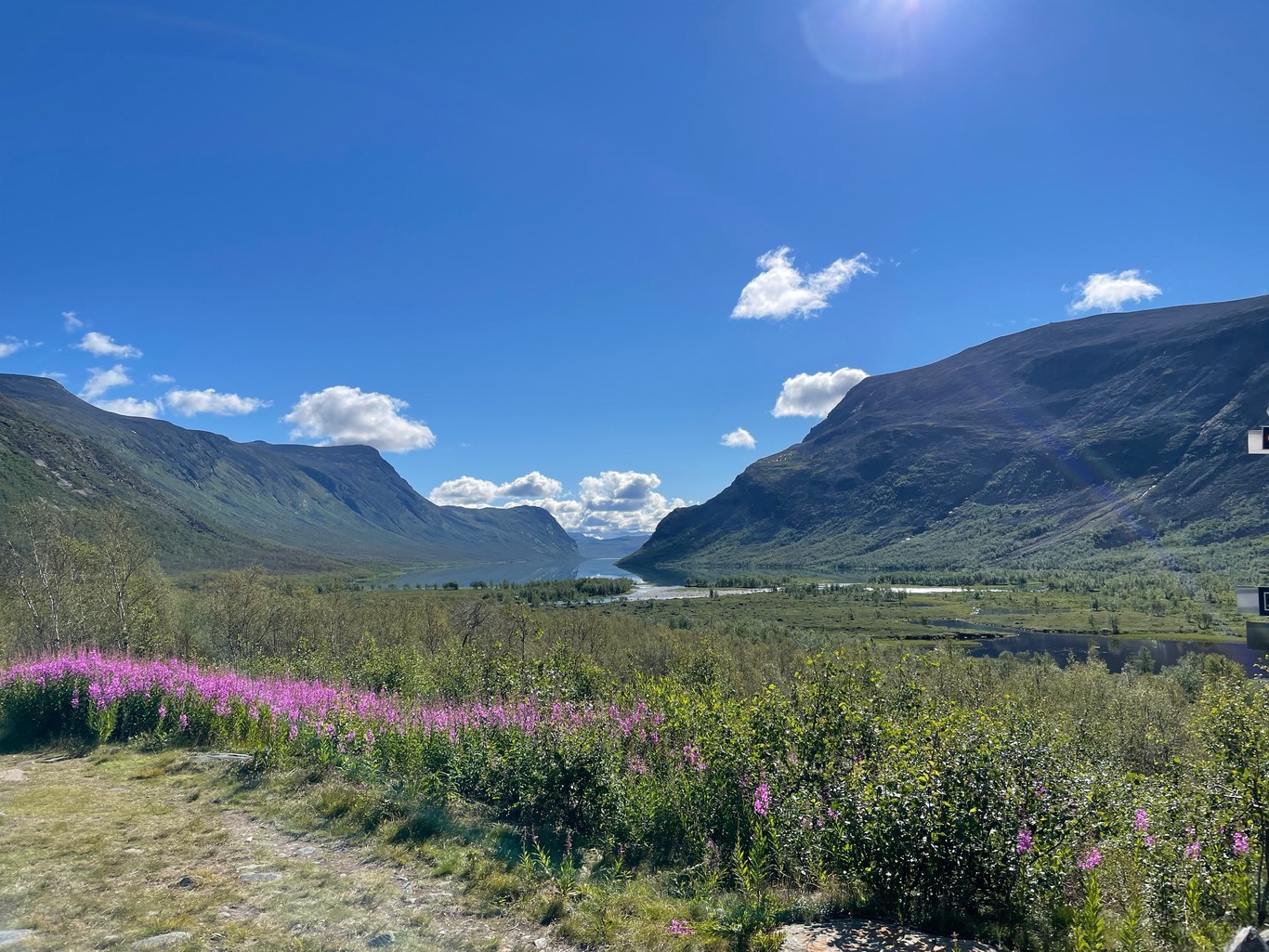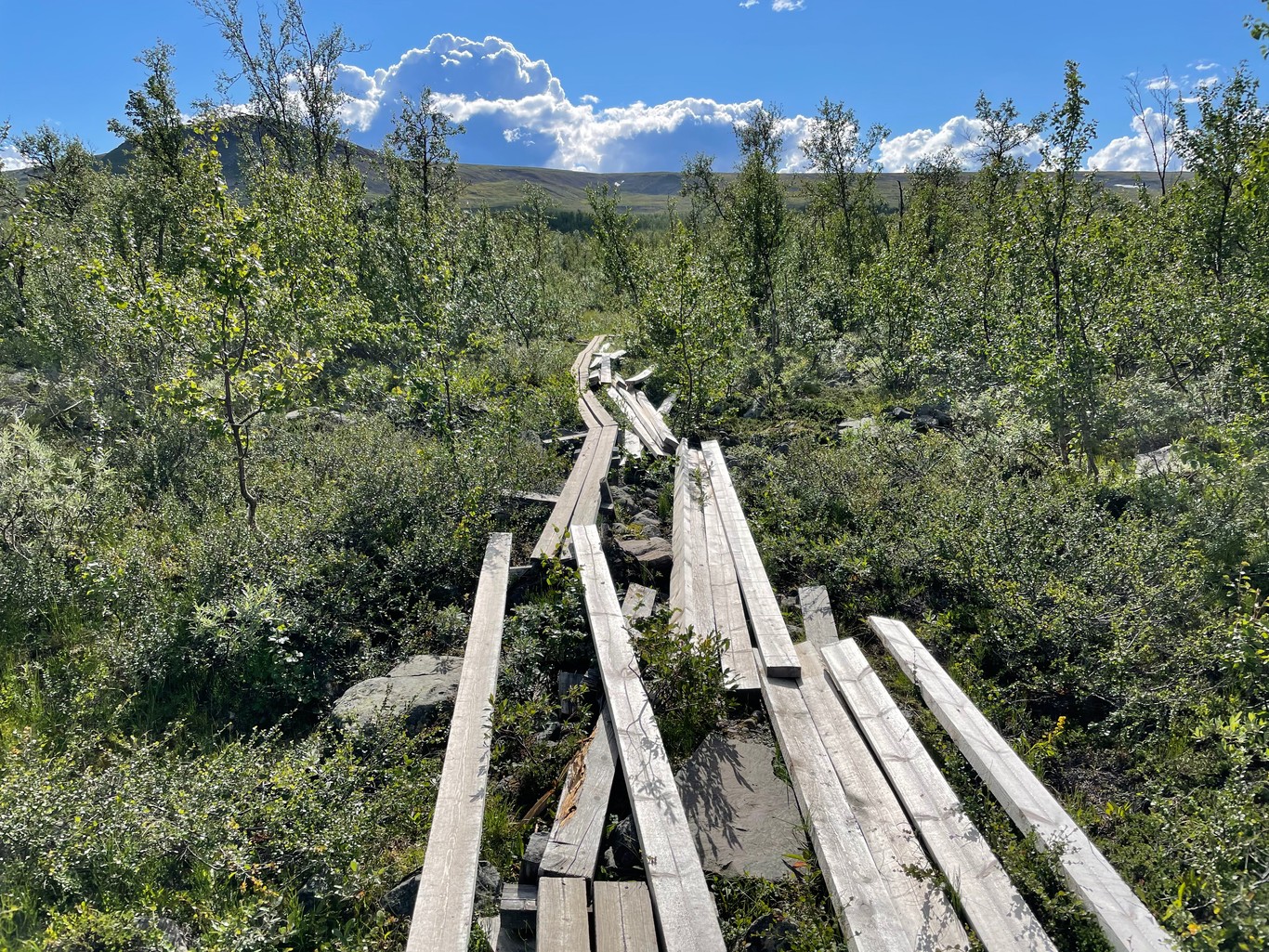Trip Report: Kungsleden
A while back I heard that one of my friends, Felicia, was heading to the Arctic Circle in the north of Sweden for a month, working as an assistant at the Tarfala Research Station. This station, situated at 1135 m elevation in a valley surrounded by glaciers, was also conveniently located next to a renowned hiking trail: the Kungsleden (“King’s Trail”).
Established in the early 20th century by the Svenska Turistföreningen (STF), the trail traverses diverse landscapes including glacial valleys, alpine plains, pristine lakes and forests of mountain birch and conifers. With three other friends—Vanessa, Suzie and Léo—our plan was to meet Felicia at Tarfala, then spend the next week tramping (hiking) south to Kvikkyokk— about 148 km of walking.
En route
Soon enough, Vanessa, Suzie and I were boarding our night train, with Léo due to take one the day after due to some logistical issues. For the trip north we’d managed to reserve the same booth, sharing it with three other people. The booths are setup with seats that convert into two three-storey bunks for the night. Apart from the logistics of me wearing an FFP3 mask trying to sleep, the ‘couchettes’ were surprisingly confortable, and even used proper cotton sheets!
Day 1
After a connecting bus from the train station, we eventually arrived at Nikkaluokta around midday. Setting off into the birch forest in the on-again/off-again rain, we eventually turned off the main trail to begin the ascent into the rocky, glacial valley of Tarfala. Stopping occasionally for snacks/lunch on the trail meant meeting the local mozzies (mosquitos), but thankfully we’d been prewarned to bring hats with large mosquito nets attached! However, trying to eat and wear mozzie nets creates an interesting challenge, with Suzie managing to get some feta cheese stuck in her net.
Courtesy of strong 4G mobile reception (a novelty!) we were able to coordinate our arrival with Felicia, who met us partway down the trail with a flask of hot coffee and some biscuits for some last-mile motivation. After a few more kilometres of tramping in the rain, we arrived at Tarfala where we were able to get dry and enjoy a tour of the facilities, and learn about what had been keeping Felicia busy for the last month. We were lucky to be able to take advantage of the station’s sauna—including obligatory naked dips in the nearby jokk (mountain stream). That evening, the station staff had got the England–Sweden women’s Euros football match on screen… with the end result being something the Swedish personnel would rather not talk about.
Day 2
The next morning we headed for Kebnekaise fjällstation (mountain station), a well-equipped facility with a restaurant and shop—like the mobile reception, a novelty for a New Zealander not used to these sorts of things in the backcountry. The journey back down the valley was uneventful, except for our first reindeer sightings of the trip. We had a leisurely lunch while we waited for Léo to tramp up the valley to join us. As we relaxed, the trees outside the window started bending more and more with the wind—a sign of things to come in the afternoon.
Setting off in very high winds, we forced our way up the wide glacial valley, passing the turn-off to Kebnekaise, Sweden’s highest peak. Eventually we managed to find a relatively sheltered spot behind a moraine further up the valley, where we intended to make camp for the night. However, upon unfurling the tent that Léo and I were meant to sleep in, we discovered that the pegs were missing—a crucial component, particularly when windy! Figuring no good decisions could be made when hungry, we cooked dinner and then sheltered under the vestibule of the other tent as we figured out our options:
- Léo and I would sleep in the drafty vestibule of the functional tent, or
- Léo and I would tramp another 8 km to the STF Singi fjällstuga (mountain cabin), where we would try and get a bed for the night.
Opting for the latter, we made out way up the dull valley shrouded in grey clouds, arriving at the fjällstuga around 11 p.m.. After reading a note on the warden’s door, we were thankfully able to find a couple of spare mattresses in dining areas of one of the huts. I ended up in the ‘dog’ side of the hut, where a curious but well-behaved border collie came out to greet me.
A quirk of tramping in the Arctic Circle is the incredibly long days. Despite the clouds doing their best to block out the sun, the sunrise and sunset for that evening was about 11:13 p.m. until 2:27 a.m.—just over three hours of (relative) darkness. An eye mask was certainly a handy thing to carry on the trip to help ensure a good night’s sleep.
Day 3
One of the problems with being in the dining room is having to wake up at the same time as the other hut users… and it wasn’t helped by one of the dogs deciding to walk over me at 6-something a.m. Nonetheless, after some accidentally-stolen coffee, the early morning start became more bearable. While waiting for the other three to join us, Léo and I had a good chat with the other hut users who were from all over the place—including another New Zealander who had made a life for himself in Switzerland, and a couple of Lithuanians who generously offered Léo some chocolate upon learning that it was his birthday.
Despite optimistic promises of a 9 a.m. arrival, it ended up being late morning when Felicia, Vanessa and Suzie joined us for a breakfast/brunch of spiced porridge. Their arrival was marked by an enthusiastic rendition of a birthday song in Swedish, and a present for Léo in the form of some Marabou chocolate.
The day’s walk consisted of an easy 13 km down a wide valley, arriving at the STF Kaitumjaure fjällstuga, beautifully situated next to a thunderous mountain river with a beautiful lake view. Handily, the fjällstuga was equipped with a wood-fired sauna, which we took full advantage of later in the evening after making camp and enjoying some food. Honestly, New Zealand should get in on the sauna culture—a great way of relaxing tense muscles after a day’s tramping! The only thing to spoil the fun was the ever-present mozzies, which made things like brushing teeth and eating food an interesting exercise.
Day 4
Day 4 dawned sunny and bright, and after another leisurely start (including petting some huskies) we continued our way south towards Teusajaure. The walk consisted of a gradual ascent over a wide saddle, before a steep drop into a valley that, according to a sign, is considered one of the most beautiful valleys in Sweden. Lunch was had at a high viewpoint, where another bunch of Swedes sang Léo a (late) birthday song as we prepared the day’s lunch—including a bonus run back down the trail for Léo after something fell off the back of his pack.
One of the novelties of Kungsleden is the lakes that need to be crossed along the way. Sometimes a ferry is the only option, but other times there are free rowboats made available. The only downside is that if the north/south traffic flows are unbalanced, it is necessary to make multiple trips across the lake to ensure that there is always at least one rowboat available on each side of the lake. That afternoon, there was a bit of a backlog of people waiting to row over, so we enjoyed some time lolling about on the (surprisingly low mozzie) lake front. Some entertainment was provided by some clueless trampers who couldn’t quite figure out how to row and were taking a very indirect circular path across the nominally 800 m crossing. Soon enough it was our turn, and after a couple of journeys and a rowboat shuffle, we were soon on our way again.
Andra sidan är ni klara?
Jajamänsan fattas bara!
A Swedish chant to be yelled enthusiastically
After crossing a small alpine stream, Suzie and I headed to a patch of snow in a shaded spot, mostly so we could say we’d been on snow in the Arctic Circle! We ended up making camp not far from the stream, and with the temperatures dropping quickly we settled into our tents for the night—but not before a quick game of ‘Dealbreakers’.
Day 5
Setting off again under a blue sky, we headed through green alpine meadows then across a field covered in large glacial boulders, before rapidly descending to yet another lake—this time with a road next to it. Our original plan was to tramp the next 30 km along the road, but we decided that that wasn’t going to be particularly enjoyable so booked a bus instead. Whilst we waited for the bus, we found a nice spot next to the lake to have lunch—and go for a swim, for those happy to brave the glacial lake temperatures!
Around 2 p.m. the bus showed up and we were soon en route to Saltoluokta. What we didn’t realise is that there would be a 30 min stopover at a scenic café, handily stocked with freshly baked kanelbullar (cinnamon buns) and hot coffee—which had to be consumed all too quickly before boarding the bus again. From here it was a very short journey to a wharf where another ferry took us across to the STF Saltoluokta fjällstation where we restocked some supplies and passed a couple of leisurely hours as electronic devices charged—at which point one of our group realised their power bank was left on the bus!
After a brief walk in the wrong direction, we soon reoriented ourselves back onto the trail south which took us up through mature conifers to another alpine plain. We pitched our tents with a wide view of lakes and mountains to the west, with the slowly descending sun creating some of the longest shadows I’d ever seen.
Day 6
Awakening to another ‘bluebird’ day, we set off on the trail, eventually reaching (yet another) lake in the early afternoon. This lake had another ferry crossing, run by a local Sámi family. Once on the other side, Felicia and Suzie went on a unexpectedly long mission to find a stream for water, after which we all enjoyed a tasty lunch of vegan scrambled ‘eggs’. The next section involved traversing a boggy immature forest, replete with mozzies that were so voracious they would even bite through multiple layers of clothing—however this didn’t stop Vanessa from attempting to clean herself in a stream we passed along the way! Fortunately, passing through the forest was a reasonably simple exercise thanks to the various wooden planks on the trail. Some of these planks had been turned into proper boardwalks, others had been simply dropped by a helicopter presumably to be turned into boardwalks—but were being used by people anyway. A good exercise in balancing!
Eventually we left the forest behind and ascended around 350 m to another high point with good views of the surrounding landscapes. Not much later, we arrived at our campsite for the night on the hills behind the STF Aktse fjällstuga. Not long after pitching our tents, the rain that had been menacing our evening finally arrived. Suzie and Léo generously volunteered to do meal prep that evening, so the rest of us could huddle in the tent-provided shelter. It was fair to say there were minimal complaints about the food, even though the salt had been accidentally left out! Entertainment that evening was provided by listening to radio commentary of the women’s Euros final between England and Germany, as well as Suzie’s enthusiastic football chants.
Earlier that day, Felicia had also come across a big patch of ripe cloudberries (Rubus chamaemorus) which she had picked for dessert… that was, until they ended up scattered on the ground after the bowl was dropped. However, they proved perfectly edible the next morning after sitting in rain water overnight!
Day 7
Waking up without the sound of rain on the tent was a solid way to start the day, and on emerging from the tent we were rewarded with beautiful views of the glassy-flat lake and valley below, the picture completed by slowly rising wisps of cloud. After breaking camp, we did a short walk down through forest to the STF Aktse fjällstuga, the fresh smell of post-rain forest filling the air. After a quick restock of some supplies, we continued to the lakeshore for another spot of rowing. Fortunately there were two rowboats waiting for us at the shore, however Suzie and I had the fun of trying to row the 3 km stretch of water with broken rings where the paddles would normally go, which meant we had to row more ‘canoe’ style. After getting across, we unfortunately found nobody else there which meant we had to get at least one boat back to the other side. Thus, Léo and I set off for our 6 km return trip, rowing a Czech couple over with us in the process. About half-way over we ran into two boats heading north—meaning that had we waited then we wouldn’t have had to do the transfer—however we couldn’t have relied on this being the case.
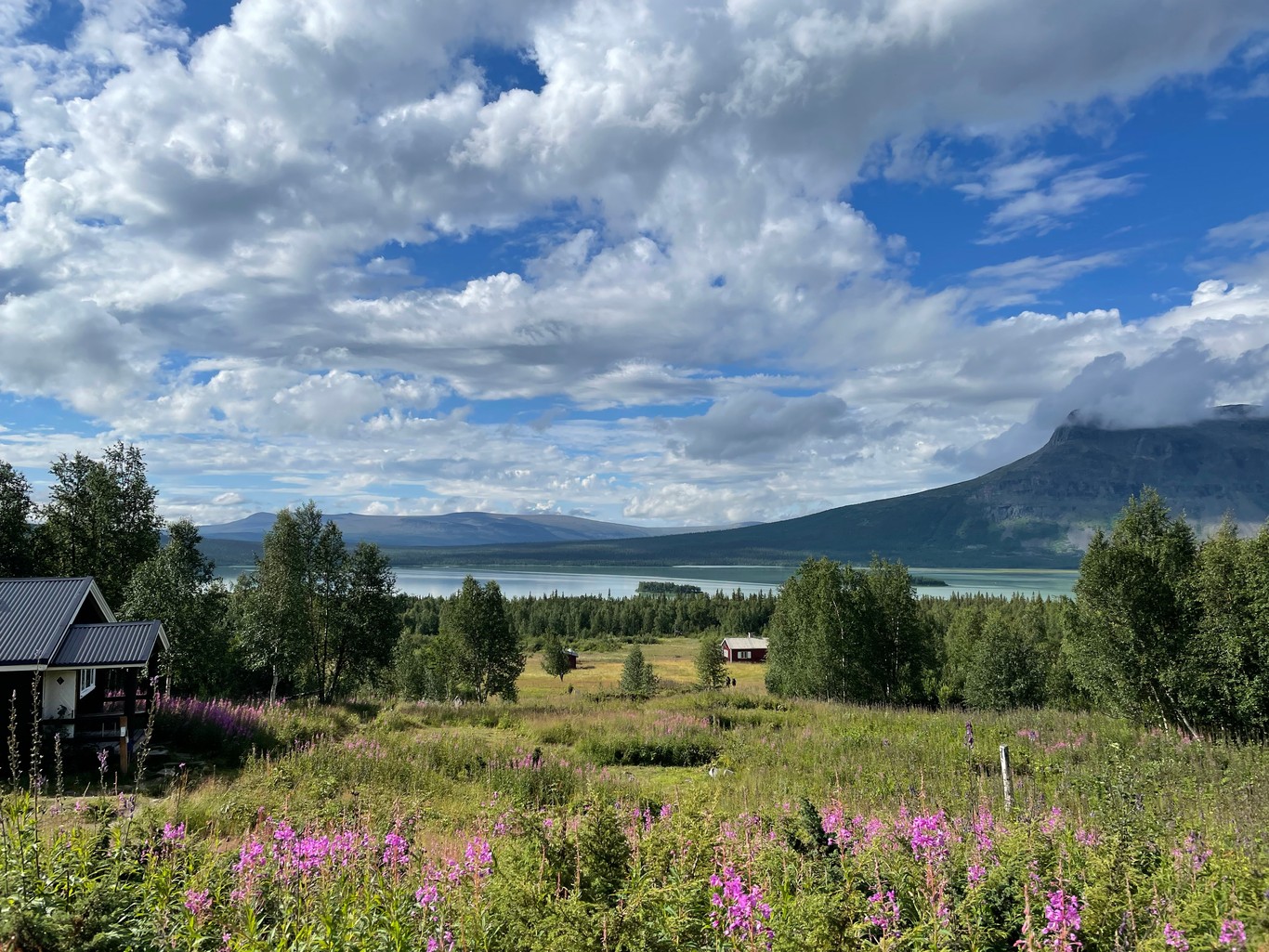 The lake viewed from STF Atkse
The lake viewed from STF Atkse
In the meantime, Vanessa, Felicia and Suzie had prepared a tasty hot lunch, complemented by wild blueberries that Felicia had picked nearby. By about mid-afternoon we were back on the trail again, crossing conifer forest before ascending above the bushline again where we had a brief coffee break at the Jågge shelter, with the nearby clouds and occasional thunderclaps signalling the rain that would soon be upon us. It wasn’t long until we were completely soaked, turning our walk into a bit of a silent trudge, each of us caught up in our own thoughts.
 An example of what’s on offer at the STF shops, including processed cheese in a tube (selection may vary)
An example of what’s on offer at the STF shops, including processed cheese in a tube (selection may vary)
We arrived at the STF Pårte fjällstuga just after 9 p.m., where we were fortunate to run into an absolutely lovely elderly camp host—I hope when I’m her age I’m able to do the things she does! Luckily there was an available room where we could light a fire and get warm and dry before retiring for the night. This was probably some of the best money spent of the whole trip, particularly when the alternative would have been going to bed damp and cold. Despite being well-practiced, my attempts at lighting a fire were going poorly and drew the attention of our camp host, who pointed out that the birch bark could be used to help get the fire going. In my defence, birch bark is not a common material for lighting fires back home!
 Just when the rain started to arrive
Just when the rain started to arrive
Day 8
After a leisurely breakfast while we waited for the worst of the rain to subside, it was late morning when we began our 15 km plod though the muddiest section of the trail. Lunch was spent about halfway down the trail, eating hot noodle soup while huddling under a wooden platform mounted between a couple of conifers. Everyone had a slightly different approach for rationing the remaining digestive biscuits and Marabou chocolate—two staples of the trip—with some opting to leave more chocolate for later for a last minute motivational boost.
However, thanks to some long group conversations the last 8 km went faster than expected and we soon arrived at the STF Kvikkjokk fjällstation, signalling the end of our tramp. We took full advantage of the facilities on offer including hot showers, proper beds and a restaurant. We also finally got to use the packs of cards I had lugged all the way over the trail without being used!
Back to Stockholm
After an excellent buffet breakfast, Léo and Suzie had to disappear early to catch a different train, leaving Felicia, Vanessa and me to hang out in Kvikkjokk until the mid-afternoon bus. An uneventful bus journey would take us to Murjek, where after another couple of hours wait a night train would arrive to take us back to Stockholm. I had the unfortunate pleasure of missing out on a sleeping couchette, and instead got lumped in a family booth—meaning very little room for me to stretch my legs without getting in someone else’s personal space. Nonetheless, despite my discomfort the night train did its job and got us back to Stockholm, but a nap was definitely needed later that day.
It was such a neat privilege to be able to go do this tramp in the north of Sweden. I think if I’d written a list of things I wanted to do while living overseas, exploring the Scandinavian outdoors would’ve been right up near the top! It also proved to me that wilderness can indeed be found in Europe, so long as you’re willing to share it with the mozzies and surprising amounts of mobile reception.
 The crew: (L-R) Léo, Vanessa, Suzie, me, Felicia
The crew: (L-R) Léo, Vanessa, Suzie, me, Felicia
